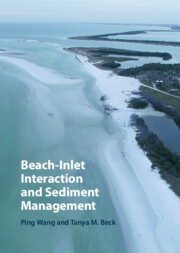Book contents
- Beach–Inlet Interaction and Sediment Management
- Beach–Inlet Interaction and Sediment Management
- Copyright page
- Contents
- 1 Introduction
- 2 Beach and Inlet Systems under Different Geological and Oceanographic Settings
- 3 Hydrodynamics and Sediment Processes Applicable to Beach–Inlet Systems
- 4 Sedimentology and Morphodynamics of Beach–Inlet Systems
- 5 Interaction of Beaches and Inlets
- 6 Methods to Mitigate Beach Erosion and Ensure Inlet Navigation Safety
- 7 Regional Sediment Management at Beach–Inlet Systems
- 8 Resiliency of Beach–Inlet Systems Facing Sea-Level Rise, Storm Impacts, and Human Stresses
- References
- Author Index
- Subject Index
6 - Methods to Mitigate Beach Erosion and Ensure Inlet Navigation Safety
Published online by Cambridge University Press: 15 September 2022
- Beach–Inlet Interaction and Sediment Management
- Beach–Inlet Interaction and Sediment Management
- Copyright page
- Contents
- 1 Introduction
- 2 Beach and Inlet Systems under Different Geological and Oceanographic Settings
- 3 Hydrodynamics and Sediment Processes Applicable to Beach–Inlet Systems
- 4 Sedimentology and Morphodynamics of Beach–Inlet Systems
- 5 Interaction of Beaches and Inlets
- 6 Methods to Mitigate Beach Erosion and Ensure Inlet Navigation Safety
- 7 Regional Sediment Management at Beach–Inlet Systems
- 8 Resiliency of Beach–Inlet Systems Facing Sea-Level Rise, Storm Impacts, and Human Stresses
- References
- Author Index
- Subject Index
Summary
Prior to the 1950s, general shore-protection practice was to use hard structures to protect against beach erosion or storm damage. Generally, the hard structures can be divided into two categories. The first category functions through anchoring the position of either a shoreline or a dune-line, such as seawalls and revetments. The second category is mainly sand-trapping structures such as groins and detached breakwaters. Realizing that the accumulation of sand produced by a structure is at the expense of an adjacent section of the shore, since the 1970s, 90% of the US Federal appropriation for shore protection has been for beach nourishment. Although beach and dune nourishment has become by far the most dominant approach to shore protection, principles of hard engineering structures are still reviewed in this chapter. More recently, since the 2010s, Engineering with Nature (EWN), defined as the intentional alignment of natural and engineering processes to efficiently and sustainably deliver economic, environmental, and social benefits through collaborative processes, are being promoted and applied more and more. The concept and practice of EWN are introduced in this chapter.
Keywords
- Type
- Chapter
- Information
- Beach-Inlet Interaction and Sediment Management , pp. 182 - 244Publisher: Cambridge University PressPrint publication year: 2022

